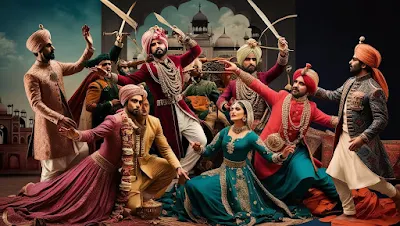The India's history is a rich tapestry woven from the diverse influences of its various eras, cultures, and peoples. The period preceding and succeeding the Mughal Empire marks a significant transformation in the socio-political and cultural landscape of the Indian subcontinent. This essay aims to explore the dynamics of Indian history from the pre-Mughal era through the Mughal reign and into the post-Mughal period, examining how regional influences from east to west and north to south shaped the socio-political fabric of India.
The Pre-Mughal Era: A Mosaic of Cultures and Dynasties
Before the ascendancy of the Mughals in the early 16th
century, India was characterized by a plethora of regional kingdoms and
dynasties, each contributing to the continent's rich heritage. From the ancient
Indus Valley civilization, which thrived around 2500 BCE, to the Mauryan and
Gupta Empires, the foundation of Indian culture was laid through remarkable
advancements in philosophy, mathematics, science, and art.
The Mughal Era: A Period of Synthesis and Flourishing
The Mughal Empire, established by Babur in 1526, was
influential in synthesizing the various strands of Indian culture. The Mughals
brought forth an era characterized by a unique amalgamation of Persian culture
with indigenous traditions, resulting in rich artistic and architectural
accomplishments. The reigns of Akbar, Jahangir, and Shah Jahan were
particularly notable for their patronage of the arts, religious tolerance, and
administrative reforms.
The decline of the Mughal Empire in the 18th century
culminated in the disintegration of centralized power and the emergence of
regional kingdoms. The Maratha confederacy rose as a prominent power in western
India, asserting its influence over large territories. In the north, the rise
of Sikh power under leaders like Maharaja Ranjit Singh heralded a new chapter
in regional governance, while in the south, the Nizam of Hyderabad and the
Nawabs of Bengal asserted their autonomy from Mughal suzerainty.
This fragmentation set the stage for colonial interests to
intertwine with Indian politics. The British East India Company, after the
victory at the Battle of Plassey in 1757, embarked on a systematic conquest of
India. The downfall of the Mughal Empire was hastened further by the Revolt of
1857, an episode that united various factions against the colonial powers,
although it ultimately failed to reverse British dominance.
The British Invasion of India and the Role of the East
India Company
The British invasion of India marks a significant chapter in the annals of colonial history, characterized by a complex interplay of trade, power, and cultural exchanges. The East India Company, initially founded in 1600 as a trading body, played a pivotal role in this transformation, culminating in British imperial dominance over the Indian subcontinent. Understanding the dynamics of this invasion and the East India Company's involvement provides insight into the economic and political motivations that shaped colonial rule in India.
As the East India Company consolidated its power, the
implications for Indian society were profound. The introduction of British
administrative practices and legal systems disrupted traditional governance
structures and altered social dynamics. While certain economic benefits
emerged, such as the development of infrastructure and the introduction of
Western education, these changes were often overshadowed by exploitative
practices that prioritized British economic interests. The imposition of heavy
taxation and the prioritization of cash crops led to widespread economic
distress among Indian farmers, culminating in famines and social strife.
By the mid-19th century, the Company's rule faced mounting challenges from various quarters, including discontent among the Indian populace and increasing calls for reform. The Indian Rebellion of 1857, also known as the Sepoy Mutiny, underscored the growing resentment against British authority and the Company’s oppressive practices. The aftermath of the rebellion marked a significant shift in British policy, leading to the dissolution of the East India Company in 1874 and the formal establishment of direct British rule in India, known as the British Raj.
Conclusion:
India’s history from the pre-Mughal era through the Mughal Empire and into the post-Mughal period represents a complex interplay of local and foreign influences, cultural exchanges, and socio-political dynamics. The shifts in power, from regional kingdoms to colonial authority, have not only shaped the Indian subcontinent's historical trajectory but also laid the groundwork for its contemporary identity.
the British invasion of India and the subsequent dominance
of the East India Company transformed the subcontinent in numerous ways,
intertwining economic exploitation with profound societal changes. The legacy
of colonialism remains a critical aspect of contemporary discussions
surrounding identity, governance, and economic policy in India. Understanding
this historical context is essential, as it not only highlights the
complexities of imperialism but also serves as a reminder of the resilience and
agency of the people within the colonized regions. The East India Company, once
a mere trading entity, ascended to become a symbol of both opportunity and
oppression, marking a defining epoch in Indian history.
As we consider India's past, it becomes evident that each
period built upon the foundations of the previous ones, resulting in a
multifaceted society that embraces diverse languages, religions, and
traditions. Understanding this intricate historical context is crucial for
grasping the current complexities of Indian society, as India continues to
navigate its path in a rapidly changing world, while remaining deeply rooted in
its rich and diverse heritage.















